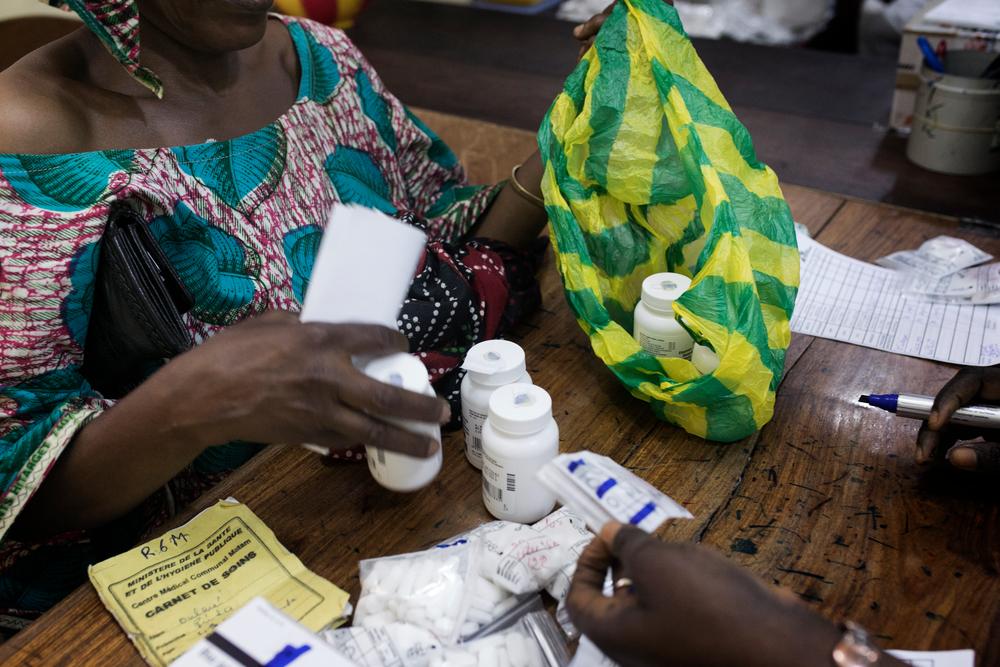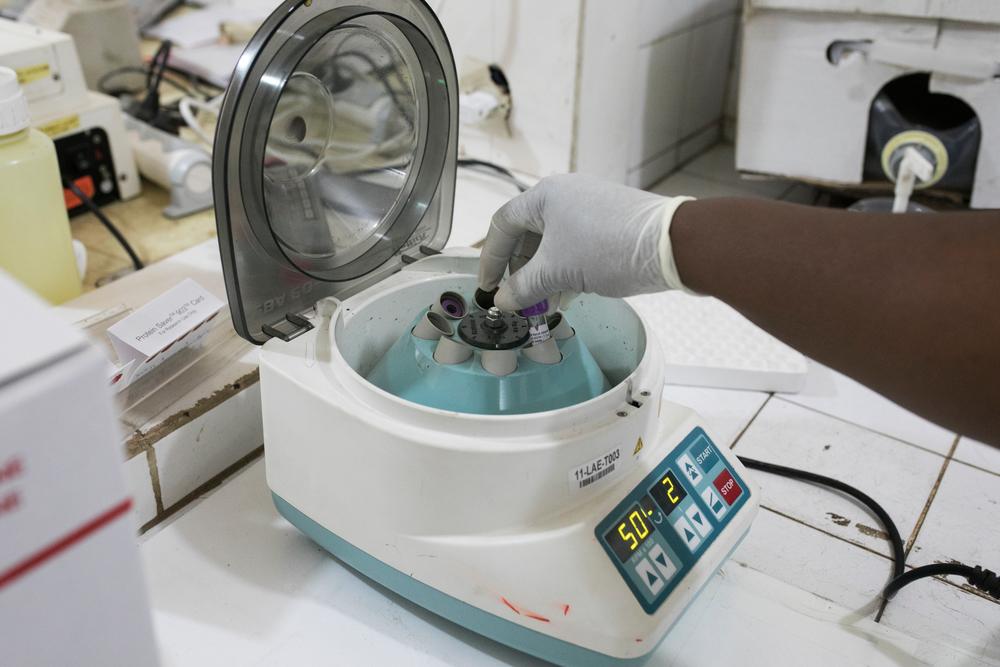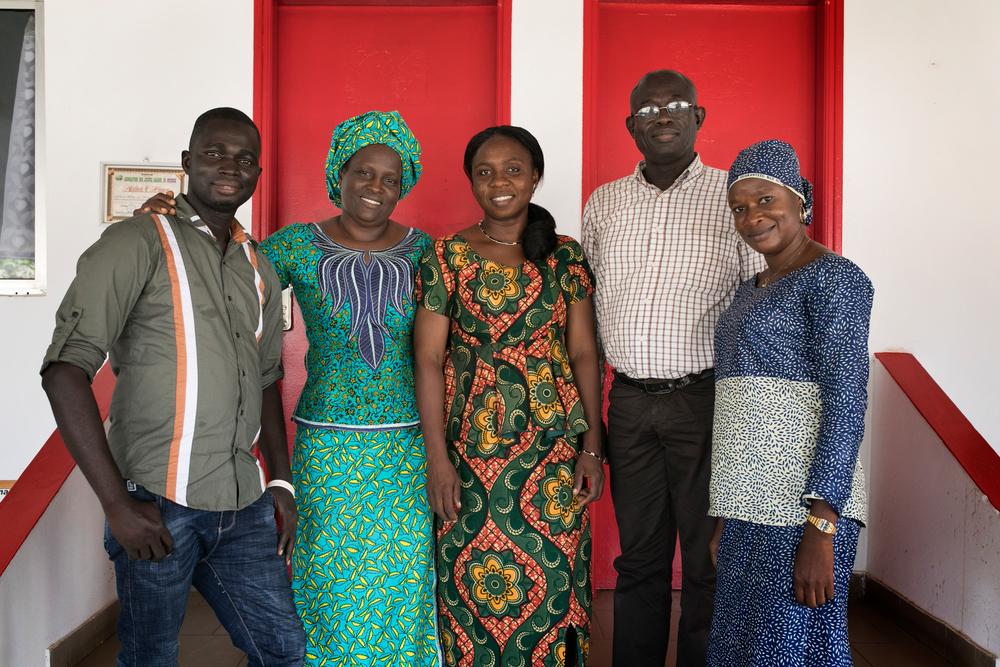Guinea: Progress made in HIV care but major challenges remain

A Guinean Health Ministry midwife performs an Early Infant Diagnosis (EID) test on a newly born infant (12 weeks old) who was born to an HIV positive mother. Doctors Without Borders supports PMTCT activities in 7 health centres in Conakry, including HIV testing, treatment for HIV positive mothers, prophylaxis and Early Infant Diagnosis (EID) for infants born to HIV positive mothers, and the initiation of HIV positive children onto ART. Guinea, 2018. © Albert Masias/MSF
In 2003, teams from Doctors Without Borders/Médecins Sans Frontières (MSF) in Guinea started treating HIV patients with antiretrovirals by opening free HIV testing and treatment centres in Conakry. Twenty years later, while much progress has been made, Doctors Without Borders is still one of the key organisations tackling the disease and major gaps remain in testing and treatment.
In 2003, Guinea was not an obvious choice of location to open an HIV/AIDS project. In contrast to countries in the epicentre of the pandemic, like those in Southern Africa, where up to one in four adults were living with HIV, just 1.7% of Guineans were HIV-positive. This low prevalence meant that HIV/AIDS treatment and care was not prioritised among people’s other health needs, and as a result, access to treatment was limited.
“It was the early 2000s, I was sick all the time, I saw lots of doctors but no one could tell me what was afflicting me,” recalls Maïmouna Diallo, known as Mouna, who now works with Doctors Without Borders as a community focal point. “My older brother, who lived in Europe, helped me financially and took me to England to get tested. Although I couldn’t understand what they were saying, I understood it was serious.”
Despite being stigmatised by some members of her family, Mouna was supported by her family and specially her brother, who paid for her to get antiretroviral (ARV) medications from abroad. “He said he would help me no matter what, even if he had to sell his house,” she says.

A patient collects her six months of antiretroviral therapy (ART) and related drugs at Doctors Without Borders-supported pharmacy as part of her six-monthly R6M consultation at the Doctors Without Borders-supported HIV outpatient department at Matam health centre, Conakry. Guinea, 2018. © Albert Masias/MSF
Due to the cost and the difficulty of getting hold of ARVs, some patients went on and off treatment and, as a result, developed resistance to the first-line medications, making it even more difficult to find an effective treatment regimen. Aboubacar Camara, an Doctors Without Borders community educator, who is also living with HIV, says: "At some point, my treatment wasn’t well-tailored anymore. I would stop and start. I developed a resistance to the treatment. So, we had to adapt to it."
In 2004, Doctors Without Borders became the first organisation to provide ARVs free of charge for HIV patients in Guinea, three years before they were made available for free countrywide.
Over the next decade, the number of HIV patients receiving treatment grew rapidly. Today, Doctors Without Borders provides care for 16,425 HIV patients, which represents 20% of the 86,000 patients on treatment countrywide.
From the early days of the programme, Doctors Without Borders focused activities on the prevention of mother-to-child transmission (PMTCT). “I had two children who were born HIV-negative thanks to the prevention of mother-to-child transmission programme,” says Kadiatou Bodié Baldé, president of REGAP+, a community-based organisation for people living with HIV. “Today, they are nine and 13 years old. My daughter knows my status and she is my confidante. I've explained everything to her so that she would not be shocked later. I told her not to touch my blood if I were to cut myself someday. She understands, she's the one who reminds me to take my medication.”
“Doctors Without Borders’s PMTCT programme in Guinea yielded exceptional results,” says Hippolyte Mboma, Doctors Without Borders project coordinator. “As a result of the programme, less than 5% of children born to HIV-infected mothers have a positive status, compared to 20% at the national level.”
Innovative models of care
A few years into the programme, Doctors Without Borders realised that, despite providing access to free care and treatment, many people with HIV were still slipping through the gaps. Because only one in four of Guineans living with HIV were on ARVs in 2012, mortality linked to HIV remained high. Advanced care for people who developed AIDS-related complications was available only in a few health facilities, such as the dermatology department at Donka hospital and the Ignace-Deen hospital, both in the capital, Conakry. Doctors Without Borders therefore decided to create a specialised care unit inside the Donka hospital, in collaboration with the Cissé professor, to take care of patients with advanced HIV, including care for people co-infected with TB and palliative care.

Outside Doctors Without Borders’s medical care unit for AIDS patients at the Unité de Soins, Formation et Recherche (USFR) in Donka Hospital, in partnership with the Guinea Ministry of Health. Guinea, 2018. © Albert Masias/MSF
In parallel, Doctors Without Borders piloted the application of the latest HIV treatment guidelines and was one of the first organisations to introduce viral load monitoring in Guinea.
With ARV treatment, HIV becomes a manageable, chronic condition, allowing one to live a long and healthy life. But this is only the case if patients take their ARV treatment every day without fail. This can be more difficult than it sounds, especially when it requires a monthly visit to the doctor in a country with few health professionals. To address the issue, Doctors Without Borders teams in Guinea developed the ‘six-month appointment programme’ (known as ‘R6M’) whereby clinically stable patients receive enough supplies of ARVs to last for six months, instead of just one, thereby cutting the time, costs and travel needed to access treatment, and allowing patients greater autonomy in managing their condition.
This initiative proved successful: in 2022, 92% of patients enrolled in Doctors Without Borders’s R6M programme were still enrolled in care after 12 months, compared to 61% of people in the regular programme. “When the R6M programme worked on our end, the national health programme rolled it out nationally,” says Doctors Without Borders’s Dr Chaloub Souleymane. “The ministry of health has become the flag bearer of R6M on the international level.”
In the same spirit, Doctors Without Borders brought into Guinea other successful, simplified models of care, developed elsewhere, that allowed patient treatment to be decentralised and taken closer to the community. This included the ARV treatment distribution points (PODIs), first piloted by Doctors Without Borders in Democratic Republic of Congo in 2010 and introduced in Guinea in 2020.

Blood samples in the Doctors Without Borders-supported laboratory await the addition of reagent before being tested for viral load levels using the Bio Centric machine. Guinea, 2018. © Albert Masias/MSF
Implications for the community
“Simplifying the provision of care for patients while offering specialist medical treatment for advanced HIV were both ways to decrease mortality and improve people’s lives,” says David Therond, Doctors Without Borders head of mission. “But we soon realised that these were not enough, because the level of misinformation, fear and therefore discrimination were powerful factors preventing people from getting tested and starting treatment. By contrast, seeing HIV-positive people in good health because they have been receiving ARVs is the only truly effective way of changing people’s mentalities, decreasing stigmatisation and increasing demand for treatment.”
From 201 onwards, Doctors Without Borders worked closely with community-based organisations, community mediators and patient volunteers who could talk about their condition and, crucially, show that one could live a long and healthy life with HIV. “It’s not HIV that kills – it’s the stigma and lack of information,” says Mouna.
Aboubacar was diagnosed with HIV in 2008. "After I took the test, the doctors had stapled a piece of paper to my notes that said: “HIV positive”. They thought I was illiterate. I looked at the paper and fell off my chair. It was beyond me. The doctor prescribed treatment for three months. After three months, I started to get better. Once my prescription ran out, I didn't renew it. I didn't want the entire town to my diagnosis, but then the disease got worse. I was being stigmatized and discriminated against. I attempted suicide twice. I had no information about the virus. It was the end of my world.”
Peer support was Aboubacar’s lifeline. “One day, I was listening to a show on the radio in which an activist, a peer educator at Doctors Without Borders, was talking about HIV and her diagnosis. She spoke the same language as I did. At the end of the segment, they gave out a phone number. I called it and the next day, I met up with that same activist. She said: “If you accept your disease, you will be just like me. I live with HIV, but I’m not going to stop living. I found comfort in that group. I even forgot I was sick.”

Doctors Without Borders’s patient experts (who are part of Doctors Without Borders’s psychosocial team) are themselves people living with HIV, who received treatment and care from Doctors Without Borders, and went on to become patient experts in their own right, to help others living with HIV. They are also active members of local HIV associations, and very engaged in their communities. Guinea, 2018. © Albert Masias/MSF
Since then, as a member of a patient-led organisations and as an Doctors Without Borders peer educator, Aboubacar has been providing support to other patients. He was one of the first people in the country to talk publicly about his status. "I came up with slogans like "HIV may be in my blood, the struggle against it is in my soul". Today, I'm still helping to demystify HIV in Guinea. My role is to share my experience with other sufferers. To encourage them to accept their illness, to live positively like me.”
In Guinea, stigma against people with HIV has generally reduced but it remains a problem in some communities, particularly for sex workers and men who have sex with men. Both groups face difficulties accessing secure testing and care.
Yassine Diallo has worked with Doctors Without Borders since the beginning of the project as a maintenance worker and administrative assistant. He is HIV negative, but talks about HIV prevention to his family, friends and neighbours without fear. “We can’t choose our diseases, but if I had to choose between HIV and diabetes, I would choose HIV,” says Yassine. “As long as you keep taking your treatment, HIV is no longer a problem. HIV isn’t dangerous with treatment, although it is lifelong.”
Major gaps remain
Twenty years on, despite the innovations and the progress in HIV care in Guinea, challenges remain in terms of prevention, testing, treatment and funding.
Today, not all health facilities in Guinea offer free complete care for HIV patients. Due to financial barriers and stigma many patients still arrive at the Doctors Without Borders supported HIV unit at Donka hospital in the advanced stages of the disease. There are recurrent stock-outs of ARVs and a sometimes faulty supply chain. In addition, many health professionals are not sufficiently trained in the management of HIV and comorbidities.

The waiting area in the Doctors Without Borders-supported HIV outpatient department at Matam health centre, Conakry. Guinea, 2018. © Albert Masias/MSF
The majority of Guinea’s HIV response is covered by the Global Fund, but massive gaps remain. PMTCT services are not available everywhere; viral load and early infant diagnosis are not available to all patients; and the screening, prevention and treatment of opportunistic infections are not available within primary health services.
Children, in particularly, face problems accessing testing and treatment for HIV. Today, 11,000 children aged 0-14 are living with HIV, and only 3,612 of them are on treatment. “There are monthly shortages that can occur in paediatric HIV medications, which can lead to backlogs of up to three weeks. That’s where Doctors Without Borders gets involved: we cover the gaps,” says Dr Souleymane. “Adults and even children can spend weeks without receiving treatment, which can lead to the emergence of strains that are resistant to ARVs. Some children born to HIV-positive mothers do not have access to paediatric prophylaxis at birth, partly because of paediatric ARV shortages, while some other children living with HIV are not on ARV treatment.”
The UNAIDS 95-95-95 objectives are to diagnose 95% of all HIV-positive individuals, provide ARV treatment for 95% of those diagnosed, and achieve viral suppression for 95% of those treated by 2030. If the country wants to achieve this, it will involve a mobilisation of everyone involved – the Ministry of Health, the Global Fund and other donors – and an acceleration of the current response.